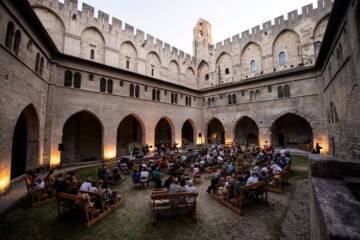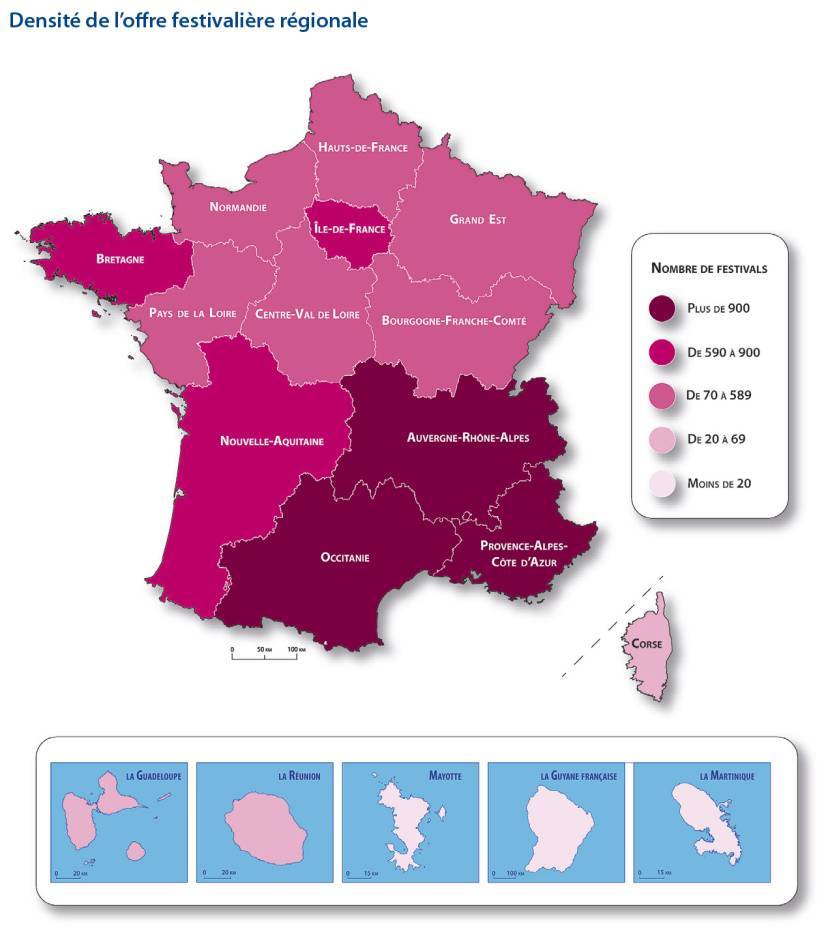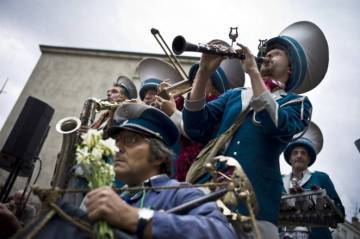A veritable identity card for festivals, an unprecedented survey designed by the French Ministry of Culture, France Festivals and the Centre d'études politiques et sociales sheds light on the extent of «festival-making» in France.
This was one of the strong recommendations of the Estates General of Festivals, an event held in 2020 under the aegis of the Ministry of Culture: better understanding the nature – and scope – of the “ festival-goer », which has evolved considerably in recent years with an abundance of events, of very diverse nature and size, distributed both in urban and rural departments.
This is now being done with an ambitious mapping project, which is drawing up a real “identity card” of all the festivals held in France in 2019, the reference year before the health crisis. « These 7,300 festivals are of very varied size and scope, explain the authors of National Festival Mapping, the study conducted by the Department of Prospective Studies, Statistics and Documentation from the Ministry of Culture, Cepel and A., cultural agency Nouvelle-Aquitaine and mapped by Stéphane Coursière. Some have several dozen different proposals, while others are more like a village festival inscribed in an artistic or cultural approach. This great diversity forms the richness of the festival-goer, which developed in favor of the cultural policies carried out from 1981, highlighting the event dimension and its festive aspect. »
A festival offering focused on the sun and the coast
First lesson: the distribution of festivals is mainly oriented towards the sun and the coast. Among the 7,300 festivals surveyed in 2019 by the study, a large number are concentrated in the south of France: the Auvergne-Rhône-Alpes, PACA and Occitanie regions each have more than 900 festivals, 830 for Nouvelle-Aquitaine. « We observe an effect of heliotropism and the attractiveness of the sun in terms of festival implantation ” explains Edwige Millery, Research Fellow at the Ministry of Culture (DEPS). These four regions – which account for almost half of the events surveyed – are pioneers in several disciplines: avignon festival for the performing arts, Vienna for jazz, the Choregies of Orange, the cannes film festival or Montpellier Danse…
Reporting this number of festivals in relation to the population, other phenomena appear since this time Corsica is the best endowed region with 20 festivals per 100,000 inhabitants, followed by the PACA region (19) and Brittany (18), which confirms the attraction for coastal areas. Note the density of the offer in Guadeloupe, which has 12 festivals per 100,000 inhabitants. At the departmental level, this coastal tropism is still confirmed with a high density of events in the Alpes-Maritimes, the Bouches-du-Rhône, the Pyrénées-Orientales and Finistère.
Festivals often born during the last decade
Today, only 3% of events were founded before 1980, a prolific decade of event creation. “ Before these years, the creation of festivals corresponds to individual adventures with a variable territorial location, in cities or in rural areas. In the 1980s, there was an amplification that coincided with the Lang decade, when culture was lived as a holiday. The event dimension is promoted and promoted. We are also in a context of decentralization following the Deferre laws of 1982-83: each community seizes the festival-making fact and there is a mimetic effect of vocation to create festivals ” recalls Edwige Millery.
During the 1990s, this diffusion at the level of local authorities continued with a rise in power of current music and the birth of major events such as the Old Plows or the Eurockéennes de Belfort. But the 2000s will mark a slight halt with a slowdown in public funding for culture on the one hand and a more general uncertainty regarding the economy of Western countries on the other. « In spite of everything, we still see an intensification of the festival dynamic with the enlargement of aesthetics to the street arts in Chalon, electro or visual arts », completes Edwige Millery.
Since 2010, the festival has been particularly dynamic: nearly half of the festivals counted in 2019 have been created in the last decade. « This shows a strong renewal, pursues Edwige Millery. We also note that the increase in the number of festivals is combined with the expansion of disciplines. » All communities – metropolises, urban departments, rural worlds – now have their own events, for example, from old village festivals. « It is the end of the festival exception that creates a new problem, that of the distinction of events in relation to each other », adds Emmanuel Négrier, director of Centre for Political and Social Studies (Cepel) at the University of Montpellier.
Festival rhymes with summer
The summer period, more conducive to outdoor events, is the most popular since four out of ten festivals take place during the summer months. The regions of the south of France are once again particularly concerned by this «geo-seasonality», the festivals being often synonymous with tourist attractiveness for these territories. On the other hand, northern France prefers an out-of-season programme, such as Île-de-France, where 44% of festivals take place before the summer, compared to one in five during the holiday season, and the Hauts-de-France, where only 25% of festivals take place during the summer season. « This is explained by the climate but also the urbanity of these territories: in large cities and metropolises, festivals take place rather out of season ” says Millery.
This preponderance of the choice of summer is not without problems of saturation of the event space and therefore of competition, which leads the programmers to turn out of this season. « We also see links with cultural and social actors established in the territories with programming out of season. Festivals are increasingly taking place in these new times of festivalisation ” explains Edwige Millery. Example in some rural departments of central France (Cantal, Allier, Nièvre, etc.), where the pre-season takes on more weight thanks to a contract with local cultural actors.
A domination of the musical offer
The cartography confirms the importance of music in the festival offering, which dominates in all regions (44% of the offer), especially in Brittany where it represents more than half of the festivals. « This domination is much more important in this region given the stronger musical traditions than in the south », according to Emmanuel Négrier. Music is often the gateway for festival creators before they open up to new disciplines.
To complete the podium, two other disciplines: live entertainment (22%) and literature (12%). With two notable exceptions in Occitania and Île-de-France, where literary festivals are less important in favour of cinema and audiovisual. The departmental level confirms this leading trio with a dominant music except in the Pyrénées-Atlantiques, Haute-Vienne and Cantal where the live show comes first.
The key figures of the study
- 7,300 festivals were held in 2019
- Almost half festivals have been created over the past decade
- Music tops the offer with 44% festivals, followed by live entertainment (22%), books and literature (12%), cinema (9%), multidisciplinary festivals (6%) and visual and digital arts (5%)
- Near four festivals out of ten are held in summer




